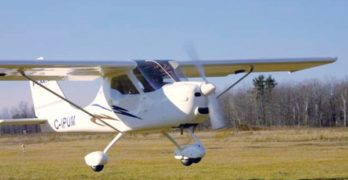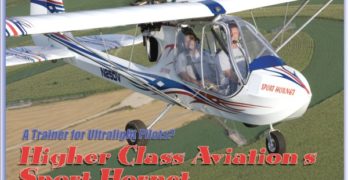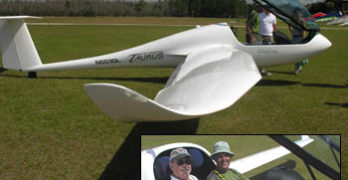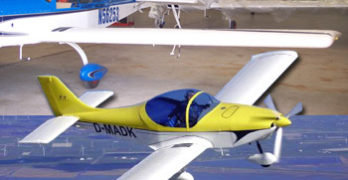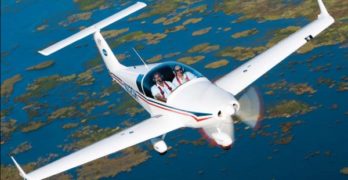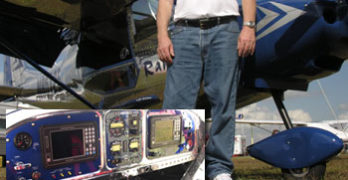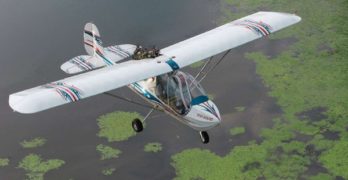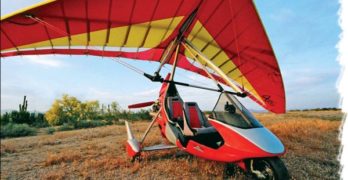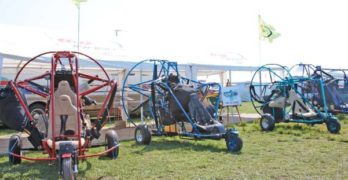One of Canada’s best-kept secrets can be found hidden
away in a northeastern Ontario town called Hawkesbury. That
secret is the PUMA – a little plane being imported into Canada by
Humberto Dramisino of Otreb Technologies.
When you look into the history of ultralight and light sport aviation,
it’s interesting to note that the successful manufacturers are the ones
that introduce a design and then adjust it as times goes by to better fit
the ever-changing aviation marketplace.
This is what has lead to the success of the PUMA. Designed in Italy
by Antonio Bortolanza, the aircraft has undergone a number of design
transitions since it was first introduced in ’85. Dramisino has been
involved with the manufacture of the PUMA from a very early age. He
first started working in the factory when he was only 15 years of age,
“working just for the pleasure of working on airplanes,” he says.
Search Results for : electric
Not finding exactly what you expected? Try our advanced search option.
Select a manufacturer to go straight to all our content about that manufacturer.
Select an aircraft model to go straight to all our content about that model.
NH:Higher Class Aviation’s Sport Hornet
At the close of business on January 31,
2008, 2-seat ultralight trainers and overweight
single-seater “ultralights” – as
readers of this publication understand these aircraft
– will cease to exist. More correctly, they
must have been converted to Experimental-Light
Sport Aircraft (ELSA) if their owners want to continue
flying them; otherwise these pilots’ options
are sharply limited.
But as Part 103-compliant ultralights continue
and if ultralight trainers go away, how will new
ultralight pilots be trained for flight in these
lightest of aircraft?
Happily, the subject of this month’s flight
review answers that question. Arguably the first
fixed-wing ultralight to make the jump – not to
ELSA conversion status but to full, Special-LSA
(SLSA) approval – is Higher Class Aviation’s
Sport Hornet.
Gaining Higher Class
We first saw the Hornet when Jim Millett
brought this new design to Sun ‘n Fun ’94 (the
event’s 20th anniversary). It was a bold move into
a market looking well established.
Rotax 503 Launch…then, Silence is Golden
Some of you know the Pipistrel line. Americans have seen two of their models: the Sinus and Virus (yep, those awkward, even distasteful names…except representatives prefer to say SEEN-us and VEER-us). Fortunately Taurus is easier on the American tongue, thanks to Ford and its auto model by the same name. *** I discovered Taurus is also easy on the ears as I went for a two-hour soaring flight from Wallaby Ranch with my hang gliding friend, David Ledford. His side-by-side Taurus — roomy for a soaring machine — glides beyond 40:1 and manages a sink rate barely more than 100 fpm. Those numbers translate into plenty of soaring power as we proved on a day with modest convective lift. *** Taurus is a self-launched sailplane, rather than a motorglider like Urban Air’s Lambada or Pipistrel’s own Sinus. To get aloft, we were powered by a Rotax 503 two-stroke engine that fits neatly into a cavity aft of the cockpit.
Renewed Breezer II SLSA Ready for Delivery
They are lining up, literally, at Sportsplanes.com’s Plant City, Florida airport (PCM) assembly station. Michael Zidziunas — everyone calls him “Mike Z” — assembled three of the new Breezer II SLSA and arranged for DAR inspection. Mike Z is a well-known flight instructor and licensed mechanic working in the LSA arena. *** Last fall, at the AOPA Expo, Josh Foss of Sportsplanes.com unveiled the new Breezer II. The all-metal low wing was introduced more than a year earlier but disputes over the design rights and manufacturing put a halt to shipments. Since then, German designer Ralf Magnussen found a new investor, Dirk Ketelsen, a builder of windmills for electric power generation. They established a new 17,000 square foot plant near Husum, Germany (west of Hamburg at the North Sea coastline) where Josh reports they can build more than 100 aircraft a year.
CubCrafters All-New Sport Cub
Vintage Looks Mated With Modern Materials
Take 25 years of experience
with rebuilding Piper Cubs,
add a new FAA regulation
allowing more flexibility in designing
and producing aircraft, spice the
mixture with many design changes,
and you get CubCrafters’ Sport Cub.
The Yakima, Washington-based company
has created an airplane that retains
the vintage look of a J-3 Cub
but embraces 21st century materials
and technology.
On a warm evening during
the Sun ‘n Fun Fly-In
at Lakeland, Florida, I
flew with CubCrafters’
pilot Clay Hammond. He
identified company President
Jim Richmond as the primary
motivator behind the Sport Cub.
Richmond has been rebuilding Cubs
for 25 years, during which time he
conceived many changes he wanted
to try. Taking into consideration his
height-he’s 6 feet 4 inches tall-he
wanted to make all the improvements
he’d envisioned for the venerable
Cub, and he wanted the airplane
to fit him.
A Thoroughly Modern Cub
CubCrafters took on the redesign
of the 50-year-old airplane using
modern materials and engineering
software not available to Piper engineers
when the J-3 was created.
Canadian-Designed Czech-Built Skylark
A Doubly International LSA
SportsPlanes.com imports several
light-sport aircraft (LSA)
that have found ready buyers.
After researching through
several designs, SportsPlanes’ owner
Josh Foss originally settled on the
Comco Ikarus C42 and Breezer and
the U.S.-built American Flyer for its
fleet. Most recently, the company
added the Czech-built Dova Skylark
to its offerings.
However, the real story of this company
is not Josh Foss’ care in the selection
of what airplanes to sell. What
may be more important to the marketplace
is the network his company
has built to bring service and support
to SportsPlanes.com’s customers.
Currently, 15 SportsPlanes centers are
operating, with the goal to establish
25 centers nationwide.
Investigating the Skylark
My opportunity to fly the Skylark
came while attending the U.S. Sport
Aviation Expo in Sebring, Florida, in
January. I flew with Darrell Hamilton,
the SportsPlanes representative
for Florida.
Darrell retired from Northwest
Airlines four years ago. He most recently
crewed the fly-by-wire Airbus
A320, which needs only small control
movements.
On the Rampage…Yet Another SLSA from Skykits
Rampage looks so dissimilar to its predecessors from Skykits that it took a second glance to make the connection. While it shares the STOL wing devices with versions of the Savannah, Rampage has a sleeker look that might broaden the appeal of these short takeoff and land designs from ICP of Italy. *** For those who got to see the new model at Sebring the airplane’s lines weren’t alone to admire. Deep blue paint was used in strategic accent to highly polished aluminum on most of the fuselage; Rampage gleamed brilliantly in Florida’s warm sun. The finish was brought inside where a polished aluminum instrument panel frame contrasted with royal blue inset subpanels (photo). Skykits director Eric Giles reported that the bright metal inside had not caused reflective problems on their long flight from western Canada. *** Rampage, the fourth SLSA model for which Skykits has gained airworthiness, uses electrically deployed leading edge slats to continue the impressive performance of the Savannah models.
The Sport Hornet
Is It the First Ultralight SLSA?
Among fixed-wing airplanes, the Sport Hornet from Higher Class Aviation
may be the first ultralight-type airplane to achieve special light-sport
aircraft (S-LSA) status. Several weight-shift trikes and a few powered
parachutes also have made the jump, making declarations of meeting the
ASTM industry consensus standards.
As company owner Robert Gaither and his team made the Hornet ready for the
LSA market, the airplane was put through a series of changes resulting in the
name Sport Hornet.
From Hornet to Super Hornet to Sport Hornet
Jim Millett, of U.S. Light Aircraft,
designed the original Hornet thinking
he could improve upon the Quad
City Ultralight’s Challenger. His was
a ground-up different design that had
only the look of a Challenger. Much
of what Jim created remains on the
Sport Hornet of today, but much has
also changed, sometimes to meet
S-LSA requirements and sometimes
because it was the right thing to do.
A Sport Bike of the Air
First weight-shift S-LSA sets the bar high
In street vernacular, the term
“crotch rocket” refers to a lean,
lightweight, high-performance
motorcycle. Sometimes called sport
bikes, these machines have become
radically snazzy in modern years by
the addition of rakish body panels.
Sport bikes accelerate like a rocket.
They corner tightly, and they turn
heads wherever they go.
The first weight-shift trike to earn
special light-sport aircraft (S-LSA) approval,
the Air Creation Tanarg might
be compared to just such a vehicle. In
fact, that’s precisely how its French
manufacturer describes its newest
machine.
Yet, while sport bikes are touchy
and have less margin for error than
other motorcycles, Air Creation’s flying
sport bike is highly stable with predictable
handling. Compare Tanarg’s
performance to other trikes, and it
comes out as a top-of-the-line entry.
The name Tanarg comes from the
highest mountain range in the Ardeche
region of southern France, not
far from the Air Creation factory.
To Infinity…and Beyond!
The world of light-sport
aircraft (LSA) includes five
classes of aircraft-airplanes,
gliders, powered parachutes, weightshift-
control aircraft (commonly
called trikes), and lighter-than-air
aircraft (balloons and airships).
While fixed-wing airplanes may be
the most prolific, they are not the
only way for flight enthusiasts to
take to the sky. Weight-shift trikes
and powered parachutes (PPCs) are
also popular modes of flights. Each
offers a different experience to pilot
and passenger.
Some fixed-wing pilots claim
no interest in powered parachutes.
While PPCs certainly aren’t fast,
they do offer one of the best viewing
platforms in aviation and have
attracted a higher percentage of
non-pilots as buyers than any other
aviation segment. That fact alone
should cause more aviators to look
closely at them.
So far three powered parachute
companies have obtained special
LSA (S-LSA) approval for their
models. The first to achieve this
was the Summit 2 from Summit
Powered Parachutes in April 2006.
- « Previous Page
- 1
- …
- 48
- 49
- 50
- 51
- 52
- …
- 67
- Next Page »


